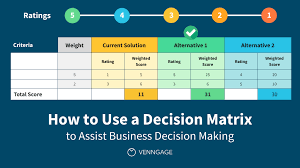Objectives of Decision Making
Decision making plays a crucial role in both personal and professional aspects of life. The objectives of decision making are multifaceted and aim to achieve specific goals and outcomes. Here are some key objectives of decision making:
- Problem Solving: One of the primary objectives of decision making is to solve problems efficiently and effectively. By making informed decisions, individuals and organizations can address challenges and obstacles in a structured manner.
- Risk Management: Decision making helps in assessing risks and uncertainties associated with different options. By evaluating potential risks, decision makers can make choices that minimize negative consequences.
- Goal Achievement: Decision making is essential for setting and achieving goals. By making strategic decisions, individuals and organizations can align their actions with their objectives and work towards desired outcomes.
- Resource Allocation: Effective decision making involves allocating resources such as time, money, and manpower in a way that maximizes efficiency and productivity. Decisions about resource allocation are crucial for optimizing performance.
- Innovation: Decision making fosters innovation by encouraging creative thinking and exploring new possibilities. By making bold decisions, individuals and organizations can drive change, adapt to new trends, and stay ahead of the competition.
In conclusion, the objectives of decision making encompass problem solving, risk management, goal achievement, resource allocation, and innovation. By understanding these objectives and incorporating them into the decision-making process, individuals and organizations can make informed choices that lead to positive outcomes.
9 Essential Tips for Effective Decision-Making Objectives
- Clearly define the decision to be made.
- Identify the goals and objectives to be achieved.
- Gather relevant information and data.
- Consider all possible alternatives.
- Evaluate the potential outcomes and consequences of each alternative.
- Take into account the risks involved in each option.
- Make decisions based on facts and analysis, not just emotions or assumptions.
- Communicate the decision effectively to all stakeholders involved.
- Monitor and review the decision’s implementation and impact.
Clearly define the decision to be made.
One crucial tip for effective decision making is to clearly define the decision that needs to be made. By articulating the specific issue or choice at hand, individuals and organizations can focus their efforts on finding the most suitable solution. Clearly defining the decision helps in setting clear objectives, identifying relevant information, and evaluating potential alternatives. This clarity not only streamlines the decision-making process but also ensures that all stakeholders are aligned on the desired outcome, leading to more informed and successful decisions.
Identify the goals and objectives to be achieved.
When it comes to decision making, a crucial tip is to identify the goals and objectives that need to be achieved. Clearly defining the desired outcomes helps in guiding the decision-making process towards specific targets. By understanding the goals and objectives, individuals and organizations can make informed choices that align with their overall vision and mission. This step lays a solid foundation for effective decision making, ensuring that every choice made contributes towards achieving the desired results.
Gather relevant information and data.
Gathering relevant information and data is a crucial tip when it comes to achieving the objectives of decision making. By collecting accurate and up-to-date information, decision makers can make informed choices that are based on facts rather than assumptions. Whether it involves market research, performance metrics, or stakeholder feedback, having access to relevant data helps in evaluating options, assessing risks, and predicting outcomes. This step not only enhances the quality of decision making but also increases the likelihood of achieving desired goals and objectives effectively.
Consider all possible alternatives.
When aiming to achieve the objectives of decision making, it is crucial to consider all possible alternatives. By exploring a wide range of options, individuals and organizations can make more informed and strategic decisions. Considering all alternatives allows decision makers to evaluate the pros and cons of each choice, identify potential risks and benefits, and select the option that best aligns with their goals. This thorough evaluation process helps ensure that decisions are well-informed and lead to optimal outcomes.
Evaluate the potential outcomes and consequences of each alternative.
When it comes to decision making, a crucial tip is to evaluate the potential outcomes and consequences of each alternative. By carefully considering the possible results of each option, individuals and organizations can make informed choices that align with their goals and objectives. This process allows decision makers to anticipate both positive and negative outcomes, assess risks, and choose the alternative that offers the best overall outcome. Evaluating potential outcomes helps in making strategic decisions that lead to successful results and minimize unforeseen consequences.
Take into account the risks involved in each option.
When considering the objectives of decision making, it is crucial to take into account the risks involved in each option. Evaluating and understanding the potential risks associated with different choices allows decision makers to make informed and strategic decisions. By assessing risks, individuals and organizations can anticipate challenges, mitigate negative outcomes, and choose the option that offers the best balance between potential benefits and drawbacks. Incorporating risk assessment into the decision-making process enhances overall effectiveness and helps in achieving desired goals with greater confidence.
Make decisions based on facts and analysis, not just emotions or assumptions.
When it comes to decision making, it is crucial to prioritize facts and analysis over emotions or assumptions. Making decisions based on concrete data and thorough analysis helps ensure that choices are rational, well-informed, and aligned with the desired objectives. Emotions and assumptions can cloud judgment and lead to suboptimal outcomes. By relying on facts and analysis, individuals can make more objective decisions that are grounded in reality, increasing the likelihood of success and positive results in both personal and professional contexts.
Communicate the decision effectively to all stakeholders involved.
Effective communication of decisions to all stakeholders involved is a crucial aspect of the decision-making process. By ensuring clear and transparent communication, decision makers can keep everyone informed about the rationale behind the decision, its potential impact, and any necessary actions to be taken. This helps build trust and understanding among stakeholders, minimizes confusion or resistance, and fosters a sense of inclusivity and collaboration. Effective communication ensures that all parties are on the same page and can work together towards implementing the decision successfully.
Monitor and review the decision’s implementation and impact.
Monitoring and reviewing the implementation and impact of a decision is a critical step in the decision-making process. By keeping a close eye on how a decision is being carried out and assessing its effects, individuals and organizations can gauge the success of their choices. This ongoing evaluation allows for adjustments to be made if necessary, ensuring that the desired outcomes are achieved. Monitoring and reviewing decision implementation also provides valuable insights for future decision-making, helping to refine strategies and improve overall effectiveness.




